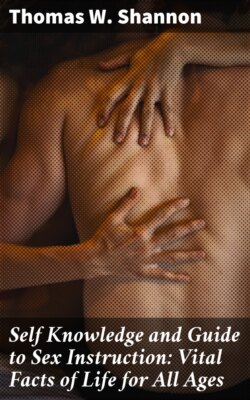Читать книгу Self Knowledge and Guide to Sex Instruction: Vital Facts of Life for All Ages - Thomas W. Shannon - Страница 17
На сайте Литреса книга снята с продажи.
CHAPTER X
THE THIRD STORY—BABY BIRDS
ОглавлениеTable of Contents
When our little girls were seven and nine this talk was given. The previous stories were reviewed bringing out the resemblances and differences. They were permitted to ask questions. In this talk they were very alert to see and apply all the lessons learned from previous stories.
The beginning of love.—In this review of the story of life, among the plants and fish, we found no love or personal feeling between the male and female. Among the insects and reptiles we found that the males and females choose each other, when led by instinct to bring their young into the world. From the fish to the birds we find the simplest form of love and interest on the part of the parents in their young. This is shown by the care the parents take in the protection and care of the eggs and the food prepared for the young before they are hatched. The male crawfish picks up the fertilized eggs with his feelers, that are arranged in a double row underneath his tail, and, by means of these feelers, he carries the eggs close to his body until they are nearly ready to hatch. The frogs and toads show great tenderness for their eggs. A great many books have been written about all these animals and when you are older you will be greatly interested in learning more of the detail of reproduction among these curious animals. Among all the animals we have studied the male and female separate as soon as the eggs are fertilized and laid, in other cases as soon as the eggs begin to hatch. The parent animals show no interest in their young after they are hatched and their children never know their parents or love them.
The ant and the bee.—Two exceptions should be made to the above statement, the bee and the ant. They do not pair off and mate, as do other insects, but they live in colonies, or societies. They do not seem to have any special interest in their offspring or even a mate, but in the whole community of bees or ants. The perfect social organizations they form and the homes they build rival the skill and intelligence of man. There are some interesting books written about the bee and ant by persons who have spent years in studying them. When you are older you may be interested in reading such books.
Baby birds.—We will study God’s plan among the birds. In studying the family life of the birds we find a higher form of instinct, more love and care for each other and their young than among the animals we have studied.
We often feel disgusted at the ugly, slimy toads, lizards and serpents living in swamps and pools. But not so with the birds. Most of them are very interesting and beautiful and some are fine musicians. Among most of the wild birds of the fields and forests, in the spring time the male chooses among the females the one that most suits his fancy and they are mated or married. When they decide to raise them a family they build them a nest. This is their home. The partridge and lark build their nests on the ground, the swallow in chimneys, the pigeons in barns, the woodcocks and woodpeckers in hollow limbs, the wild ducks and geese on the ledges of rocky cliffs, or in the high grass and weeds on the edge of a lake, but most birds build their homes in bushes and trees. The cuckoo does not build a nest, but lays her eggs in the nest of other birds, to get rid of all labor and trouble of hatching, feeding and rearing her young. We feel a natural contempt for the cuckoo. In every female bird there are organs called ovaries where at certain seasons little eggs are formed. While small or soft they are fertilized by the male bird. As the egg grows in the body of the mother bird a hard thin shell is formed around them. When the eggs are fully formed and the nest is completed, the mother bird lays the eggs in the nest, usually one egg a day. For several days these eggs must have some extra heat or they will not hatch. Among most birds, the mother sits on her eggs so that the warmth of her body will cause the fertilized cell in each egg to form the little bird. While she sits on the eggs the father bird gathers fresh berries and worms and brings them to the mother bird to eat. When not bringing her water or food, he is usually found perched upon a nearby limb cheering his wife by talking and singing to her. When her little legs become tired, he will take her place, while she goes and finds fresh food or water. When the little birds are hatched, from sunrise to sunset the parents are busy catching worms and insects and feeding their young. As their children grow older and larger, in some mysterious way, they teach them the danger of men and guns, cats and snakes. When they are about grown they are taught to fly. From this time until the next spring they will live in flocks, when they will again mate and raise a family. In this way all the beautiful feathery songsters are brought into this world.
